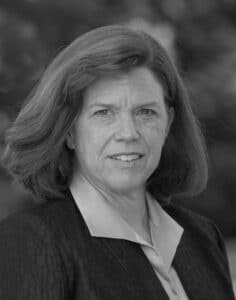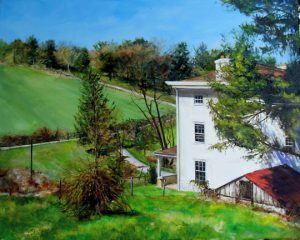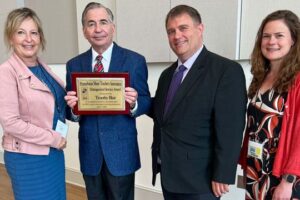The names Wyeth and Kuerner are virtually synonymous with Chadds Ford. Indeed, the Kuerner Farm on Ring Road inspired almost 1,000 of those iconic paintings by the late Andrew Wyeth. And now, almost 50 of those paintings are on display at the Brandywine Museum of Art.
According to William Coleman, the co-curator for the exhibit, Andrew Wyeth at Kuerner Farm: The Eye of the Earth, makes Chadds Ford a “story of global significance, a really remarkable tale of creative commitment.”
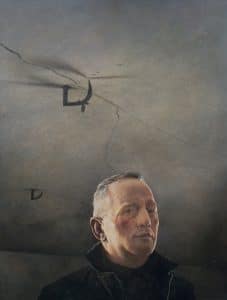
He brought up other famous artists such as Cezanne and Georgia O’Keeffe, who studied their famous subject matters deeply and compared their dedication to that of Wyeth’s.
“Nobody did it quite like Andrew Wyeth, and no subject tells that quite like the Kuerner Farm,” he said.
The exhibition overs 25 years of that dedication to a specific subject, dealing with the place and its people, from his earliest works to his later pieces.
Coleman said the totality of the work reflects a “melding and merging of realism and abstraction in a way that perhaps was not possible in the big city. This is the time of abstract expressionism. This is the time where influential critics like Clement Greenberg were saying the only way to be a modern American artist, because of the horrors of the nuclear age, is brutal, ruthless abstraction. And then there’s Andrew Wyeth outside the city, making a modern American art that finds abstraction useful at times, that finds realism useful at times. And you’ll see a huge range in between those two.”
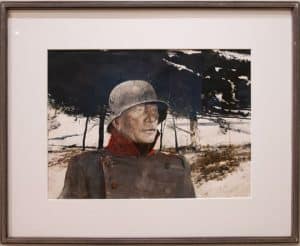
There are three sections to the exhibit: Beginnings, The People, and Visionary Realism.
Andrew Wyeth began drawing and painting under the guidance of his father, the illustrator N.C. Wyeth and the young artist would walk to the farm and sketch and paint, and it’s where he met Karl Kuerner Sr., and his wife Anna.
Beginnings includes images of the farm, with and without people. There’s Chestnut Tree and Black Hunter, and one piece entitled simply Karl.”
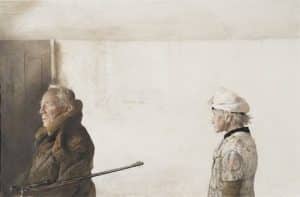
Karl shows the senior Kuerner’s face by a wall where there are hooks which were used to hang sausages, Coleman said, and he compared that painting to another one, “The German, showing the elder Kuerner in a German army uniform. Karl Sr. had been a machine gunner in the German Army during WWI.
Both images, Coleman said, show a relationship between peace and a potential for violence.
Another image called “The Kuerners” shows Karl Sr. walking out of the room, a rifle under his arm, and Anna Kuerner a few steps behind him. It’s a stark image showing the couple, done in Andrew Wyeth’s typical muted palette, against a bare wall.
Also in the exhibit is the first drawing Wyeth did of his famous model Helga Testorf, done in 1971, and a watercolor of her walking up to the Kuerner Farm on a snowy day, called Loden Coat.
There are two pieces in the exhibit that may have influenced the painting of the third generation of Karl Kuerners, Karl the artist, known by some in Chadds Ford as “Young Karl.”
Haymow is a simple image of hay in a barn, which may have influenced the young Kuerner when he painted his father unloading hay in the barn. Another Wyeth painting, Cornflower, includes a small image of Anna Kuerner, which resembles the shadow image of her that Young Karl painted in his Blink of an Eye.
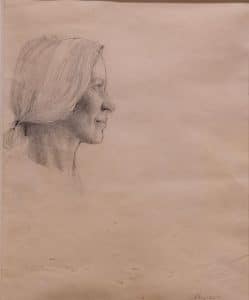
When the similarity of the pieces was brought to the attention of the painter, he acknowledged he might have been influenced, maybe just subconsciously, by those Wyeth paintings.
The link between the Wyeths and Kuerners lasted from the first meeting between Andrew Wyeth and Karl Kuerner Sr., through Young Karl being taught by Andrew Wyeth’s sister Carolyn, and the friendship between Young Karl and Andrew until Wyeth died in 2009.
Andrew Wyeth at Kuerner Farm: The Eye of the Earth is on display through Sept. 28.
About Rich Schwartzman
Rich Schwartzman has been reporting on events in the greater Chadds Ford area since September 2001 when he became the founding editor of The Chadds Ford Post. In April 2009 he became managing editor of ChaddsFordLive. He is also an award-winning photographer.

